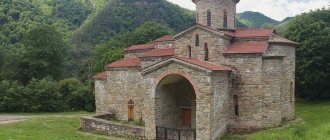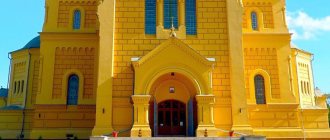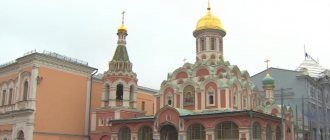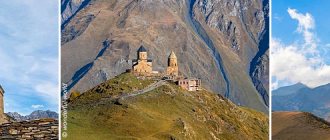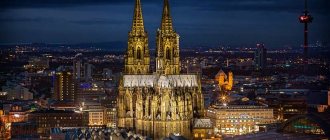Russia is an Orthodox country. The main symbol of the Orthodox faith is the temple, the house of God, the personification of his image and visible embodiment.
Russian temples with names and descriptions are presented on many pages of the World Wide Web, but the information about them is so deep, eloquent and limitless that a year or two or three is hardly enough to cover all the existing objects of stone and wooden architecture. The very best of the temples, deserving not only the attention of an Orthodox believer, but also the study of an ordinary erudite intellectual, are presented in this article.
Famous Russian cathedrals have become objects of intense interest this year. For example, in St. Petersburg, even now, the final stage of voting for the temple, which is considered the “Orthodox symbol of the city,” is taking place. The 18 best churches of the Northern capital, one way or another remembered and selected by the people, have reached the finals.
Orthodox churches: history and everyday life
The history of Orthodox churches began with the Baptism of Rus' and its adoption of the Orthodox faith in 988.
The oldest church, according to archaeological finds, is the Church of the Tithes (989-996) in Kyiv (then the territory of Rus'). It was destroyed by the Tatar-Mongols, namely by the troops of Batu during the capture of Kyiv.
The oldest temple is St. Sophia Cathedral in Kyiv, which has survived to this day. This unique monument even today bears the stamp of the atmosphere of the past and gives believers strength and hope for the eternity of Orthodoxy, embodied in stone.
In the North Caucasus there are 3 temples, more ancient than the Church of the Tithes, they date back to the early-mid 10th century. But whether they should be considered Orthodox is a controversial issue even for historians.
Southern Temple in the village of Nizhny Arkhyz
This is the so-called Northern, Middle and Southern temples in the village of Nizhny Arkhyz.
Church of the Resurrection, Foros
It is located in Crimea, near the village of Foros, at an altitude of more than 400 meters. It was built in honor of the rescue of Emperor Alexander II and his family from a train accident that happened in 1888. The initiator of the construction was the merchant Alexander Kuznetsov. The Foros temple is clearly visible from the sea and often served as a landmark for sailors and fishermen during heavy fogs and storms.
The most beautiful churches in Russia: masterpieces made of stone and wood
The most beautiful churches in Russia are considered to be those located in the cities of the Golden Ring. Yaroslavl, Vladimir, Suzdal, Rostov the Great and many others - all of them represent “living evidence” of faith that has survived to this day, mainly from the pre-Petrine era (XVII century).
Church of Elijah the Prophet in Yaroslavl
Crowned with domes and decorated with tiles and frescoes, these temples are still active today.
Church Fr. Kizhi
The best embodiment of wooden architecture are the temples on the island of Kizhi and in Karelia.
Wooden church in Suzdal
This is a dying art, of which only a few have survived - in some villages and hamlets, in Suzdal and Surgut.
St. Nicholas Cathedral, St. Petersburg
The temple is made in the memorable Elizabethan Baroque style. The request for the construction of the cathedral was submitted by Prince Mikhail Galitsin; it was erected at the end of the 17th century at the expense of the naval department. The purpose of the temple was to personify the glory of the Russian fleet. The cathedral is complemented by an interesting bell tower with four tiers, with which it forms a single compositional and architectural group.
The largest Russian temple
The largest Russian temple is the main temple of the capital, in which the Patriarch of Moscow and All Rus' traditionally holds church holidays. This is the restored Cathedral of Christ the Savior.
It gives the impression of an ideological center, rising on the banks of the Moscow River, not far from the Kremlin wall and the Tsvetaevsky Museum.
Its golden domes, combined with snow-white walls decorated with stucco ornaments, represent the ideal image of the “House of God.” Created in the “Russian style,” the temple was originally built to commemorate the victory of the Russian people in the Patriotic War of 1812.
Restored in 2000, the temple is located on the site of one that was blown up in 1931, in the general wave of the fight against religion and the destruction of cathedrals and churches. During the Soviet years, there was a swimming pool on this site. Today, the tradition of honoring God on holidays attracts thousands of Muscovites, and huge queues line up around the temple in the evening, for example, on Christmas Eve and Easter.
St. Sophia Cathedral, Novgorod the Great
This cathedral embodies the features of both Russian and foreign architecture. The western entrance of the temple is decorated with the Magleburg Gate, made in the 12th century. According to legend, they were captured by the Novgorodians in the Swedish capital in 1187. Also in the cathedral there are the Korsun Gates. They were made in the 11th century by the Byzantines. During the Second World War, the temple was badly damaged, but was not completely destroyed. Currently, the cathedral has been restored almost to its original form.
The most unusual Russian churches
Unusual churches in Russia are diverse and original. If we ignore for a moment such primary criteria as the antiquity of churches and the participation of great architects and artists in their design, then we can name at least 5 temples that attract attention.
For example, the Znamenskaya Church in Dubrovitsy, which is crowned not with a cross, but with a crown.
The Ascension Church in Kolomenskoye is the first example of tent-roofed architecture.
The Church of the Annunciation of the Holy Trinity in Taininsky is equipped with a portal in the shape of a tower - you will not find this in any other church in Russia.
Trinity Church in St. Petersburg is popularly nicknamed “Kulich and Easter”, because resembles in shape precisely these indispensable attributes of Easter.
The Kostomarovsky convent is a cave monastery, the monasteries were built inside chalk pillars.
Church of the Sign (Dubrovitsy)
A big attraction of the Dubrovitsy village near Moscow is the Znamenskaya Church, built at the end of the 17th century by Prince Golitsyn.
The temple stands out for its huge number of decorative elements, among which there are floral ornaments, stucco moldings and unique sculptural compositions.
He forgave Klimova’s betrayal and now they are family friends. What does the Petrenko family look like?
There are only a few days left before Nikita Dzhigurda's wedding: he is marrying his ex-wife
Photo gallery of Soviet actors who brilliantly played generals in films
Which city in Russia has the most churches?
There is a clear answer to this question - in Moscow. More than 1,100 temples can be seen if you walk along the capital’s avenues, squares, streets and alleys.
St. Basil's Cathedral in Moscow
It should be noted that before the revolution, when St. Petersburg was the capital, it also had many churches: historians claim that every street in St. Petersburg ended with a church or temple.
In the memoirs of contemporaries one can find reviews that, approaching the capital, they saw many domes. All these temples were destroyed in the 1930s.
Temple of the Prince of Chernigov (Peredelkino)
The Church of the Transfiguration of the Savior (its other name is the Church of the Prince of Chernigov) is located in Peredelkino. Tourists and city guests regularly go on excursions to it to admire the beauty of this miracle at least once in their lives, which is impossible to do without stopping your heart. The Church of the Transfiguration is considered a national treasure.
In Antarctica, the snow changed color and turned into green and crimson
The world's first flying car with folding wings will debut in 2022
For inflammation and a few more reasons to include spicy foods in your diet
Why do churches have black domes?
The traditional color of church domes is gold. Green is also a common color. But black? The church with black domes in Moscow is no exception to the rule. Black domes are found on several Moscow churches.
Old Believer Church (Moscow, Turchaninov Lane)
In particular, the Old Believer Church (Turchaninov Lane), the Church of the Deposition of the Robe (Donskaya St.), the Cathedral of Donskoy Monastery, the cathedrals of Pokrovsky Monastery. (it contains the relics of Matrona of Moscow), etc.
Cathedral of the Intercession Monastery in Moscow
The mystery of the black color in the color of the domes has not yet been solved. 1st version attributes the black domes to monastic symbolism, asceticism, severity, grief for Christ.
Another version gives preference to the affiliation of the architects and builders of the temples with Masonic lodges.
Kazan Cathedral in St. Petersburg
This temple is similar in architecture to the Roman St. Peter's Cathedral. The facade of the building, facing north, is made in the Empire style. It is complemented by a colonnade located in a semicircle. The Kazan Cathedral became not only a religious building, but also a monument of Russian architecture and a monument to military glory. The square in front of the temple often became a place for demonstrations and gatherings.
Assumption Cathedrals of Russia
Assumption Cathedrals in Russia are located in many cities. All of them are dedicated to one holiday - the Dormition of the Mother of God.
It would seem a paradox - the death of the Mother of God is marked by a holiday. But the Orthodox faith teaches that Her Dormition is not death, but union with God. Some analogy to the Resurrection of Christ.
A temple built in honor of the Most Holy Theotokos will definitely have blue walls - according to the Orthodox canon.
Smolny Cathedral, St. Petersburg
This temple is distinguished by its sophistication and lightness. It began to be built under Empress Elizabeth and on her orders. The design for the Cathedral of the Resurrection of Christ was prepared by Rastrelli. The Empress dreamed of entering a monastery at the temple in her old age, but its construction was greatly delayed. During this time, the original project underwent some changes. As a result, the cathedral received not only features of Elizabethan Baroque, but also classicism.
Cathedrals of Russia
Cathedrals in Russia are the main churches of an ecclesiastical region (diocese).
A mandatory attribute in them is an elevation in the central part, the so-called. chair of the ruling bishop. It is here that the head of the diocese, the Metropolitan, conducts regular divine services.
The largest churches in Russia in terms of capacity are located in large cities - where they are needed for access of all Orthodox believers to the House of God.
St. Isaac's Cathedral in St. Petersburg
The Cathedral of Christ the Savior in Moscow and St. Isaac's Cathedral in St. Petersburg (now a museum) are ready to compete with each other in terms of footage and aesthetics of decoration.
St. Basil's Cathedral
It is located in Moscow, on Red Square. This cathedral is considered one of the most beautiful churches in our country, as well as one of the most famous religious monuments in the world. The cathedral is included in the UNESCO list. It was built in the 16th century during the reign of Ivan the Terrible. According to legend, after the construction of the temple, the unknown master who erected it was blinded by order of the king so that he could no longer create such a miracle. Today the Cathedral is considered one of the main symbols of the capital of Russia.
Salt Cathedral of Sicapira
The cathedral is called Salt Cathedral because it was built underground at a depth of 250 meters in salt mines.
The temple has 3 levels that represent the birth, life and death of Jesus Christ. It is richly decorated with ornaments and sculptures and is part of the Museum of Mineralogy, Geology and Natural Resources.
Hallgrimskirkja
Hallgrímskirkja is a Lutheran church in the capital of Iceland, Reykjavik, named after the local poet Hallgrímur Pietursson.
The architect planned to create a church in the form of flowing lava. It took more than 38 years to build. The main pride of the church can be considered a huge 25-ton organ. The building is the sixth tallest structure in the city and is therefore often used as an observation tower.
LiveInternetLiveInternet
Quote from message in the evening
Read in full In your quotation book or community!
Temples of Russia - photographs and brief description
A selection of Russian heritage, the most beautiful churches of the Russian Federation
Cathedral of the Nativity of the Blessed Virgin Mary, Rostov-on-Don.
The temple was built according to the standard design of the architect K. A. Ton and is externally very similar to his other temples built according to his designs: the Cathedral of Christ the Savior in Moscow and the Vvedensky Church of the Semenov Regiment in St. Petersburg and the Holy Spirit Cathedral in Petrozavodsk, which have not survived to this day. But to say that one is a copy of the other is wrong.
In addition, in 1887, according to the design of the military architect-engineer A. A. Campioni and the artist-architect D. V. Lebedev, on its western side, a four-tier bell tower was erected with the Church of St. Nicholas the Wonderworker, Archbishop of Myra in Lycia and a belfry, height 75 meters. The gospel of its 10-ton bell can be heard 42 versts along the Zadon region.
Kazan Cathedral in St. Petersburg, the temple of military glory, one of the most magnificent temple buildings in St. Petersburg.
The main façade of the cathedral faces Nevsky Prospekt and forms the unique appearance of the city's main thoroughfare. The temple building, conceived by the architect A.N. Voronikhin, bears the features of European classical architecture, in particular, St. Peter's Cathedral in Rome, and at the same time, the Russian architectural style with elements of eclecticism and classicism is clearly visible here. The cathedral amazes with its gigantic, slightly curving colonnade, which consists of 96 thirteen-meter columns of the Corinthian order. These huge columns are made from blocks of stone brought from special quarries in Gatchina, a suburb of St. Petersburg. And in the external design of the cathedral there are picturesque reliefs and statues.
Cathedral of Christ the Savior in Moscow
The most famous and most important cathedral in the country.
It was recreated in the 1990s on the site of the temple of the same name, created in the 19th century. The temple, 105 meters high, was built in the Russian-Byzantine style. The domes of the cathedral are made of stainless steel and covered with a thin layer of gold, and were also coated with a layer of diamond dust to protect them from atmospheric agents. The temple has 12 external doors cast in bronze. Numerous figures of saints are placed in the arches and niches of the temple. Currently, the temple has the status of a metochion of the Patriarch of Moscow and All Rus'.
Epiphany Cathedral in Elokhov (Moscow)
It was built in 1837 according to the design of the architect E.D. Tyurin. The building was built in the style of classicism and is crowned with five domes on light drums, which form the main decoration of the temple. The large central rotunda has tall semicircular windows with graceful paintings on top, separated by paired columns. The temple is crowned by a huge golden dome with a small dome at the top. The side entrances to the temple are very large, divided into three parts by columns; There are semicircular windows on top. The shoots are framed by wide paired pilasters. In 1930, the temple became the patriarchal cathedral. The Epiphany Cathedral is the heart of the spiritual life of Orthodox Russia over the last 60 years. It never closed.
Resurrection Cathedral of the New Jerusalem Monastery (Istra)
A unique temple structure, both in complexity and beauty, built in 1658-1685.
The cathedral was conceived as a copy of the Church of the Holy Sepulcher in Jerusalem, but during construction it was not an exact repetition of the prototype, but rather its artistic transformation. The cathedral consists of several parts: in the center is the four-pillar Church of the Resurrection, to the west of it is a rotunda covered with a high tent with the Chapel of the Holy Sepulcher, to the east is the underground church of St. Constantine and Helena, as well as surviving fragments of the bell tower.
Assumption Cathedral in Vladimir
Cathedral Orthodox Church of the Vladimir Diocese on Cathedral Square in the city of Vladimir.
The Assumption Cathedral is the most beautiful architectural structure of Ancient Rus', a unique monument of the Vladimir-Suzdal white stone architecture of the pre-Mongol era. Following his model, the Italian architect Aristotle Fioravanti built the Assumption Cathedral of the Moscow Kremlin. The Assumption Cathedral houses examples of art by the best artists of different times, from nameless isographers of the mid-12th century to the brilliant Andrei Rublev and masters of the 17th and 18th centuries.
Annunciation Cathedral of the Kazan Kremlin (Kazan)
It is one of the oldest and most interesting monuments of Russian church architecture.
The foundation of a wooden church on the site of the future cathedral is traced back to the acts of Tsar Ivan the Terrible. The cathedral belongs to the Pskov school of Russian architecture. During this period, masters Postnik Yakovlev and Ivan Shirai were instructed to go to Kazan to build a new stone city (Kremlin). The domes of the cathedral were originally semicircular in shape, but were redone in 1736. Four domes became onion-shaped; the middle dome of the cathedral was built in the Ukrainian Baroque style, covered with copper and gilded. Annunciation Cathedral in the Kazan Kremlin It remains the most ancient building in the Kremlin ensemble.
St. Sophia Cathedral in Veliky Novgorod
A wonderful architectural monument that has absorbed not only the features of Russian, but also foreign architecture.
Thus, the western entrance of the St. Sophia Cathedral is decorated with the famous Maglebur Gate of the 12th century. Tradition says that this is a military trophy obtained by the Novgorodians during the capture of the Swedish capital of Sigtuna in 1187. There is also the Korsun Gate of the 11th century, Byzantine work, leading to the Nativity border. During the Great Patriotic War, the cathedral was destroyed, but retained its shape. At present it is almost the same as it was in the 11th century. This is a five-nave cross-domed church with three apses.
St. Nicholas Naval Cathedral in St. Petersburg
A beautiful temple in the Elizabethan Baroque style, located on Nikolskaya Square.
It was built in the period from 1753 to 1762 (architect S.I. Chevakinsky) on the naval regimental yard on the site of a wooden church, and can accommodate about five thousand people. Next to the cathedral there is a four-tiered bell tower topped with a high spire. The majestic building of the St. Nicholas Naval Cathedral is decorated with Corinthian columns gathered in bunches, stucco platbands, a wide entablature and crowned with a gilded five-domed dome. The rich plasticity of the facade is complemented by balconies with patterned forged grilles. During the consecration, the cathedral was named naval, since the victories of the Russian fleet were celebrated there.
The Vladimir Cathedral in St. Petersburg is dedicated to the Vladimir Icon of the Mother of God, one of the most revered icons in Rus'.
This five-domed temple is an architectural monument of the transitional style from Baroque to Classicism, and includes two churches - upper and lower. Currently, services are held only in the upper church. The sails of the central dome are decorated with sculptural images of the evangelists.
Spaso-Preobrazhensky Cathedral of the Solovetsky Monastery
A majestic two-pillar temple, more than 40 meters high, which has no analogues in medieval Rus'
It is crowned with five chapters. The drum under the central head is shifted to the east and is perceived as a tent. The high vaults of the temple rest on two massive pillars, the light falls from above from the tent-drum, which seems to float above the iconostasis. The history of the main temple of the Spaso-Preobrazhensky Solovetsky stauropegial monastery goes back almost six centuries. The holy relics of the first founders of Solovetsky - the Venerables Zosima and Savvaty - are kept here.
Cathedral of the Assumption of the Blessed Virgin Mary
The largest Orthodox church in Astrakhan. Located on the territory of the Astrakhan Kremlin.
Built in 1699-1710, it is considered one of the best examples of Russian church architecture of the early 18th century, and is the only architectural temple complex preserved in Russia, where the temple and the Execution Place are connected.
Annunciation Cathedral, located in the center of Voronezh.
Built according to the design of architect V.P. Shevelev in the Russian-Byzantine style. The cathedral is located on Revolution Avenue on the territory of the Pervomaisky Garden. The height of the temple itself is 85 meters, and its highest point is 97 meters. It is the third largest Orthodox church in Russia and one of the tallest Orthodox churches in the world. Construction took place from 1998 to 2009.
Holy Trinity Cathedral in the city of Murom, on the left bank of the Oka River.
Erected in 1643. The main decoration of the Holy Trinity Cathedral are forged gilded crosses - masterpieces of blacksmith work by Murom craftsmen of the 17th century - and glazed tiles of the same century with various ornaments. The tiles give the Trinity Cathedral a special grace and unique identity that distinguishes it from other Murom churches.
Smolny Resurrection of Christ
The cathedral is part of the architectural ensemble of the Smolny Monastery, which is located in St. Petersburg on the left bank of the Neva on Smolnaya Embankment.
In the 1730s, the heir to the royal throne, Elizaveta Petrovna, decided to spend the last years of her life in the peace and quiet of the monastery, surrounded by one hundred and twenty noble maidens. Already being an empress, she ordered the construction of a monastery on the site of the Smolny House, the palace in which she lived her youth. The monastery complex was to include a temple with house churches and a bell tower and an institute for girls from noble families. The architect of the cathedral is F. B. Rastrelli.
Trinity-Izmailovsky Cathedral on Trinity Square in the Admiralteysky district of St. Petersburg.
Full name - Cathedral of the Holy Life-Giving Trinity of the Life Guards Izmailovsky Regiment. The stone cathedral, cruciform in plan, is crowned with a powerful five-domed dome. The temple was built in the Empire style. At the time of its consecration, the cathedral was the largest in Russia. The domes are painted with gold stars on a blue background according to the personal instructions of Nicholas I, given in 1826: the domes should be painted like the domes of the Archangel Cathedral in Moscow and Tver Cathedral in Tver. The facades of the cathedral are decorated with six-column porticoes of the Corinthian order with a sculptural frieze. In the niches of the porticos there are bronze figures of angels.
Cathedral of the Resurrection of Christ on Spilled Blood, Church of the Savior on Spilled Blood in St. Petersburg
The Orthodox memorial single-altar church in the name of the Resurrection of Christ was built in memory of the fact that at this place on March 1, 1881, Emperor Alexander II was mortally wounded as a result of an assassination attempt (the expression on the blood indicates the blood of the king). The temple was built as a monument to the Tsar-Martyr with funds raised throughout Russia; the project was made in the “Russian style”, somewhat reminiscent of Moscow's St. Basil's Cathedral.
Cathedral of the Intercession of the Blessed Virgin Mary on the Moat, also called St. Basil's Cathedral
An Orthodox church located on Red Square in Kitay-Gorod in Moscow.
A widely known monument of Russian architecture. Until the 17th century, it was usually called Trinity, since the original wooden church was dedicated to the Holy Trinity; was also known as “Jerusalem”, which is associated both with the dedication of one of the chapels and with the procession of the cross to it from the Assumption Cathedral on Palm Sunday with the “procession on the donkey” of the Patriarch.
Currently, the Intercession Cathedral is a branch of the State Historical Museum. Included in the List of UNESCO World Heritage Sites in Russia.
According to legend, the architect(s) of the cathedral were blinded by order of Ivan the Terrible so that they could not build another similar temple.
There are only 10 domes. Nine domes over the temple (According to the number of thrones: the Intercession of the Virgin Mary (central), Holy Trinity (eastern), Entrance to Jerusalem (western), Gregory of Armenia (north-western), Alexander of Svirsky (south) -east), Barlaam of Khutyn (south-west), John the Merciful (formerly John, Paul and Alexander of Constantinople) (north-east), Nicholas the Wonderworker of Velikoretsky (south), Adrian and Natalia (formerly Cyprian and Justina) (northern)) plus one dome over the bell tower.
Holy Trinity Cathedral
An Orthodox church, which is part of the architectural ensemble of the Pskov region and is its main building.
The site for the construction of the temple, which was to become the center of the settlement, was chosen by Grand Duchess Olga, who was born here, when she visited the Pskov land in 957. As the chronicle says, when she stood on the bank of the river, a vision appeared to her in the form of three rays pointing to this place - that is why they decided to dedicate the temple to the Life-Giving Trinity.
Military Resurrection Cathedral, Starocherkassk city.
Near the temple there is a two-tier tented bell tower 45.8 meters high. This is the only building of this type in Southern Russia.
Ascension Military Cathedral, Novocherkassk
Laid down in 1805. Its construction began in 1811, while we note that the larger St. Isaac's Cathedral in St. Petersburg will begin to be built in 1818, and the Cathedral of Christ the Savior in Moscow even later in 1832.
The seventh highest domed cathedral building in Russia after the Cathedral of Christ the Savior, St. Isaac's Cathedral, Smolny Resurrection Cathedral in St. Petersburg, Trinity-Izmailovsky Cathedral in St. Petersburg, Church of the Savior on Spilled Blood in St. Petersburg, Trinity Cathedral in Pskov.
Church of the Ascension of the Lord in Kolomenskoye
Orthodox Church of the Danilovsky Deanery of the Moscow Diocese.
The temple is located in the Nagatinsky Zaton area, the Southern administrative district of Moscow, in the former village of Kolomenskoye near Moscow. The temple is a masterpiece of world architecture, the first stone tented temple in Russia.
Features of Christian buildings
The temple building was originally different from other buildings. It was built as a house of God for performing a special ritual of worship.
The sacred buildings of Christianity were always crowned with a vaulted dome, symbolizing the sky, which created a special contemplative and sublime mood for those participating in the service. The completion of the dome is the cross, as a statement and symbol of the head of the church of Jesus Christ.
A special feature of the design of the Russian dome was its shape, reminiscent of the flame of a burning candle.
In its historically established form, the Christian temple personifies the Kingdom of God, which has come in power.
From this comes the 3-part division of the temple:
- The altar represents the hidden Divine realm of existence.
- The temple in its main part marks the spiritual sky, the upper world, the area of angelic service.
- The porch or meal represents earthly life.
Frauenkirche
Located in Nuremberg, Germany, Frauenkirche was founded by Holy Roman Emperor Charles IV in 1352. The Emperor intended it as a place for ceremonies, so there are two passages and a platform.
It was here that the emperor's son was baptized in 1361. In 1506, a mechanical clock was installed on the façade of the building.
Symbolism
The sacred buildings of Christianity have their own special symbolism hidden from the uninitiated eye. Many symbols originated in the early era of Christianity, during a period of terrible persecution, and carried the meaning of recognizing initiates.
Symbolism:
- The round dome symbolizes eternity, peace, constancy and peace in God, the overcoming and victory of spirituality over dead matter.
- Pigeon is a symbolic image of the Holy Spirit, as well as a sign of peace and spirituality of the Christian soul.
- The Lamb became a symbol of the sacrificial love of the Holy Trinity and its 2nd person, the Lord Jesus Christ.
- The lion symbolizes power and strength.
- The olive branch has become a symbol of victory and the triumph of eternal peace.
- The lily is considered the flower of the Virgin Mary and the Annunciation, symbolizing purity.
- The vines and bread recall the Eucharistic communion of faithful Christians.
- The ship depicts human life and the Church as a society, overwhelmed by the passions and unrest of the surrounding sea of life.
- The anchor symbolizes firmness and support.
- The lyre became the image of the Gospel teaching, delighting the soul.
Stavkirka in Borgunn
The Stavkirka in Borgunn is the oldest surviving frame church in Norway. Built between 1180 and 1250, the church has undergone many changes and renovations.
The roof is crowned with 4 dragon heads. There is practically nothing left inside that was there before. Now we only have an altar and a closet on the wall.
Chapel on the rock
The Chapel of Saint Catherine of Siena, better known as the Chapel on the Rock, is located in Colorado, USA.
John Paul II visited this church in 1993 and consecrated it. Despite the fact that the center, of which the chapel was part, was destroyed by fires in November 2011, it remained untouched.

